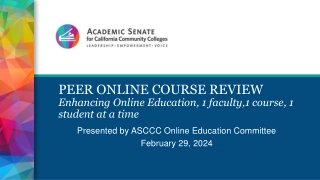
Exploring Suicide Potential and Actualising Tendency
This qualitative study delves into suicide notes to understand the underlying reasons behind individuals choosing to end their lives. It questions whether suicide can be seen as an expression of the actualising tendency, impacting counselor ethics and theory application. The research aims to shed light on a complex and sensitive subject, challenging traditional viewpoints and exploring the humanistic perspective of self-destructive behaviors.
Download Presentation

Please find below an Image/Link to download the presentation.
The content on the website is provided AS IS for your information and personal use only. It may not be sold, licensed, or shared on other websites without obtaining consent from the author. If you encounter any issues during the download, it is possible that the publisher has removed the file from their server.
You are allowed to download the files provided on this website for personal or commercial use, subject to the condition that they are used lawfully. All files are the property of their respective owners.
The content on the website is provided AS IS for your information and personal use only. It may not be sold, licensed, or shared on other websites without obtaining consent from the author.
E N D
Presentation Transcript
Exploring suicide potential and the actualising tendency: A qualitative study of suicide notes. Amanda McGarry
How did I come to this research? Proposition Four: The organism has one basic tendency and striving to actualise, maintain and enhance the experiencing organism (Rogers, 1951, p. 487). There are, of course, examples of people who cannot escape from self-destructive behaviours, which often mean they cannot become clients or benefit from counselling. Sometimes, sadly for those people, dying is the alternative to actualising (Simanowitz & Pearce, 2003, p. 52).
To explore whether suicide can ever be viewed as an expression of the AT. To gain an understanding of how this could affect counsellor s way of working in relation to ethics and application of theory. Aims and objectives. I completed a narrative analysis on a sample of suicide notes to gain understanding of the reasons people had chosen to take their life.
Background to the research current policy agenda. There are approximately 4,500 suicides in the UK per year (Dept for Health, 2019). In October 2018, the UK Government appointed its first ever Suicide Prevention Minister (Dept for Health, 2019). The current UK policy on suicide focuses on reduction and prevention (Reeves, 2010). Reducing access to means of suicide, reducing rates of self harm as a key indicator to suicide, tailoring approaches to improve mental health in specific groups (Dept for Health, 2019).
The BACP Ethical Framework (2018) highlights the principles of autonomy and non-maleficence. Background to the research - practice The Mental Capacity Act (2005) states that individuals have the right to make choices about their own life if they are deemed to have the capacity to do so. Anti person-centred Rogers & Murphy (2017) to defer to external authorities such as government or organisation policy.
Exploring the AT We can say that there is in every organism, at whatever level, an underlying flow of movement toward constructive fulfilment of its inherent possibilities (Rogers, 1980, p. 117). The AT is selective and alongside it s directionality it is also constructive stating it does not actualise its potentiality for self- destruction, nor its ability to bear pain (Rogers, 1963, p. 6). Only in circumstances that are perverse or unusual is the potential for these aspects actualised (Rogers, 1963).
Methodology and Method Qualitative approach allowing the researcher to explore the frame of reference of another in a sensitive and accurate way (Mearns & McLeod, 1984). Narrative approach with the analytic strategy of stanza analysis (Gee, 1991). By using stanza analysis the impact and emotional meaning of the text is more readily available (McLeod, 2011). 31 notes were analysed from two texts (Scheidman & Farberow, 1957, Etkind, 1997). Following stanza analysis, predominate narratives within the data were identified.
Findings Can t Can t live live with with Can t Can t live live without without The The other other No No other other Predominate Predominate narratives narratives: : Subordinate Subordinate narratives narratives: : My place Feeling not good enough The fear of (potential) shame/guilt/regret Fear of consequences of illness Failure The physical pain any longer The emotional situation any longer Best for others (financially) Best for everyone (emotionally) This is what you wanted/It s your fault This is the only way out This relationship/this love McGarry (2018)
Findings excerpts from notes Can t live with I have never been much good, I have only hurt everyone I ve thought this over a million times and this seems to be the only way I can settle all the trouble I have caused you and others . Can t live without Mary, I love Betty and I can t stand being without her Dearest Mary I just can t go on without Tim, John and you . The other. I knew that if I went to a doctor I would lose my job I think this is best for all concerned I know you will find someone better for you and the boys No other. I m sorry honey, but please believe me this is the only way out for me
Developing additional propositions of the AT. 1. The chosen action is self-directed. (Rogers, 1959) 2. Within the individual s perceptual field the action can be viewed as constructive. A) The action maintains or enhances the organism (up to the point of death if appropriate). (Rogers, 1951, Brodley, 1999 & Merry, 2008). B) The action may have a positive overall evolutionary impact. (Rogers, 1980) C) The action could be viewed as problem solving in nature. (Brodley, 1999). 3. Any action which actualises the potential to bear pain or act self-destructively is under perverse or unusual conditions. (Rogers, 1963) 4. Receiving the core conditions in therapy or otherwise would not have affected the individual s action. (Rogers, 1980). McGarry (2018)
Conclusion There were notes that when analysed against the additional propositions of the AT, indicated that the act of suicide was potentially an expression of the AT. Dear Mary, You have been the best wife a man could want and I still love you after fifteen years. Don t think too badly of me for taking this way out but I can t take much more pain and sickness also I may get to much pain or so weak that I can t go this easy way. With all my love forever Bill
Implications for practice The challenge of striking the right balance in terms of ethics, legality, your chosen way of working, the wishes of the client and your own personal position. Use of supervision (Reeves, 2015) Exploration of the judgement of whether a client s behaviour is constructive or destructive . Exploration of the ethical and legal factors of working with risk Counsellor s personal position (Reeves & Mintz, 2001). The counsellor s feeling of competence (Reeves & Mintz, 2001). Potential consequences of risk assessments (Reeves, 2018, Large et al, 2016).
References British Association for Counselling and Psychotherapy (2018a). Ethical Framework for Good Practice in Counselling and Psychotherapy. Rugby, United Kingdom: British Association for Counselling and Psychotherapy. Brodley, B. T. (1999). The actualizing tendency concept in client-centred theory. The Person-Centred Journal, 6(2), 108 120. Retrieved from http://adpca.org/system/files/documents/journal/Brodley%20ActualizingT%20PCJ6_2.pdf Department for Health (2019) Suicide prevention Cross government plan. Retrieved ftom https://assets.publishing.service.gov.uk/government/uploads/system/uploads/attachment_data/file/772210/national-suicide-prevention-strategy- workplan.pdf Etkind, M. (1997). Or Not to Be: A Collection of Suicide Notes. New York, New York, Riverhead Books. Gee, J. P. (1991). A linguistic approach to narrative. Journal of Narrative and Life History 1(1), 15-39. Large, M., Kaneson, M., Myles, N., Myles, H., Gunaratne, P., & Ryan, C. (2016). Meta-Analysis of Longitudinal Cohort Studies of Suicide Risk Assessment among Psychiatric Patients: Heterogeneity in Results and Lack of Improvement over Time. . PLoS ONE, 11(6), 1-17. 10.1371/journal.pone.0156322 McGarry, A. (2018). Exploring Suicide and the Actualising Tendency: A Qualitative Study of Suicide Notes. (Unpublished master s dissertation.) University of Chester. United Kingdom. McLeod, J. (2011). Qualitative Research in Counselling and Psychotherapy (2nd ed.). London, United Kingdom: Sage. Mearns, D., & McLeod, J. (1984). A person-centred approach to research. In R. F. Levant, & J. M. Shlien. (Eds.), Client-centred therapy and the person- centred approach: New directions in theory, research and practice (pp. 370-389). Westport, Connecticut: Praeger Publishers Mental Health Capacity Act (2005). Retrieved from https://www.legislation.gov.uk/ukpga/2005/9/contents Merry, T. (2008). The actualisation conundrum. In B. E. Levitt (Eds.), Reflections on Human Potential: Bridging the person-centred approach and positive psychology. (pp. 46-55). Ross on Wye, United Kingdom: PCCS Books.
References Proctor, G. (2017). Clinical psychology and the person-centred approach. In S. Joseph (Eds.). The handbook of person-centred therapy and mental health: Therapy, research and practice. (pp. 333 354). Monmouth, United Kingdom: PCCS Books. Reeves, A. (2010). Counselling suicidal clients. London, United Kingdom: Sage. Reeves, A. (2015). Working with risk in counselling and psychotherapy. London, United Kingdom: Sage. Reeves, A. (2018). Where do we go from zero? Therapy Today, 29(7), 30-33. Reeves, A., & Mintz, R. (2001). Counsellors experience of working with suicidal clients: an exploratory study. Counselling and Psychotherapy Research, 1(3), 172-176. 10.1080/14733140112331385030 Rogers, A., & Murphy, D. (2017). Person-centred therapy and the regulation of counsellors and psychotherapists in the UK. In S. Joseph (Eds.). The handbook of person-centred therapy and mental health: Therapy, research and practice. (pp. 376 - 387). Monmouth, United Kingdom: PCCS Books. Rogers, C. R. (1951). Client Centred Therapy. London, United Kingdom: Constable and Company. Rogers, C. R. (1959). A theory of therapy, personality and interpersonal relationships, as developed in the client centred framework. In S. Koch (Eds.), Psychology: A study of a Science. Volume 3: Formulations of the Person and the Social Context (pp. 184-256). New York, New York: McGraw-Hill. Roger, C. R. (1963). The actualizing tendency in relation to motives and to consciousness. In M. R. Jones (Eds.), Nebraska symposium of motivation (pp. 1-24). Lincoln, Nebraska, University of Nebraska Press. Rogers, C. R. (1980). A way of being. Boston, Massachusetts: Houghton Mifflin. Schneidman, E. S., & Farberow, N. L. (1957). Clues to Suicide. New York, New York: McGraw Hill. Simanowitz, V., & Pearce, P. (2003). Personality development. Maidenhead, United Kingdom: Open University Press.
Further Reading Brodley, B. T. (1999). The actualizing tendency concept in client-centred theory. The Person-Centred Journal, 6(2), 108 120. Retrieved from http://adpca.org/system/files/documents/journal/Brodley%20ActualizingT%20PCJ6_2.pdf Cooper, M. (1999). If you can t be Jekyll be Hyde: An Existential-Phenomenological exploration of lived-plurality. In J. Rowan, & M. Cooper (Eds.), The Plural Self: Multiplicity in Everyday Life (pp. 51-70). London, United Kingdom: Sage. Cooper, M. (2013). Developmental and personality theory. In M. Cooper, M. O Hara, P. F. Schmid & A. C. Bohart (Eds.), The Handbook of Person-Centred Psychotherapy and Counselling (2nd ed.). (pp. 118-135.) Hampshire, United Kingdom: Palgrave MacMillan. McGarry, A. (2019). A Person-Centred Perspective on Suicide. Healthcare Counselling and Psychotherapy Journal, 9(4), 24-27. Mearns, D., & Thorne, B. (2000). Person-centred therapy today: New frontiers in theory and practice. London, United Kingdom: Sage. Merry, T. (2008). The actualisation conundrum. In B. E. Levitt (Eds.), Reflections on Human Potential: Bridging the person-centred approach and positive psychology. (pp. 46-55). Ross on Wye, United Kingdom: PCCS Books.






















